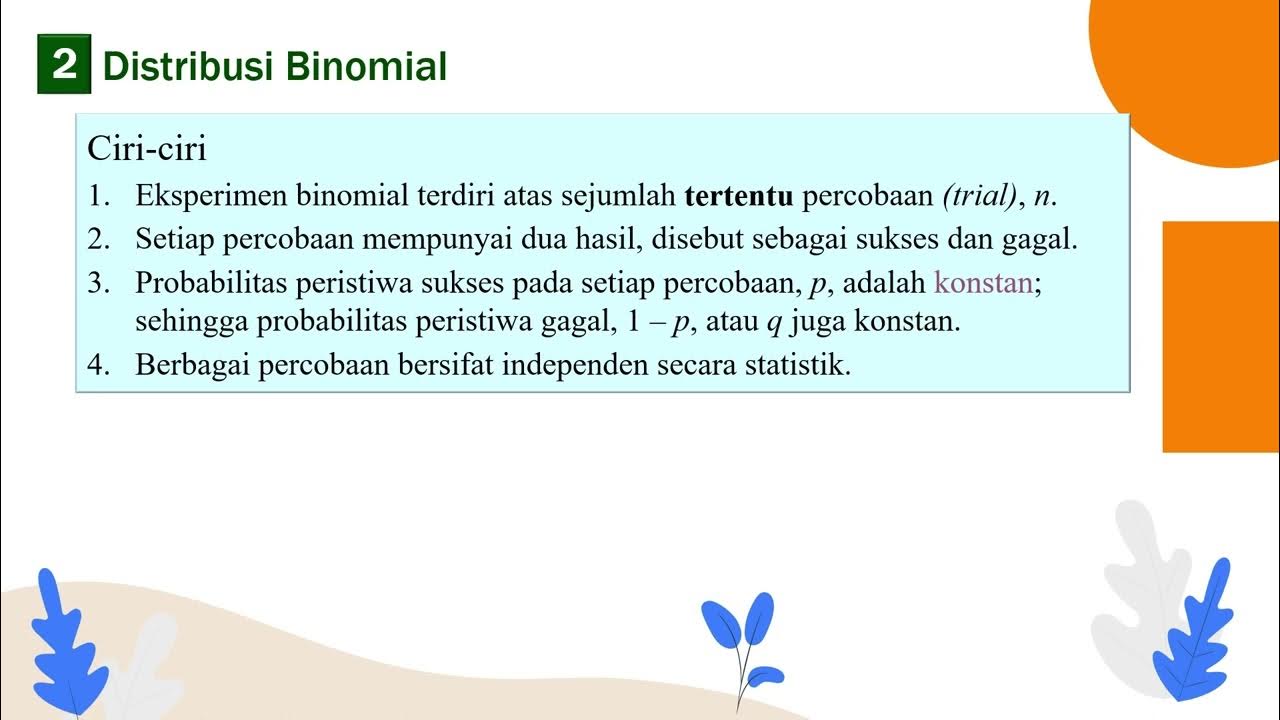Distribusi Probabilitas Binomial | Matematika Peminatan Kelas 12
Summary
TLDRThis educational video introduces the concept of binomial probability distribution, explaining binomial trials and the formula for calculating probabilities in such experiments. It covers practical examples like coin flips and soccer penalty kicks, demonstrating how to calculate the probability of specific outcomes using the binomial distribution. The video further explores the relationship between the number of trials, probability of success, and the resulting distribution. The lesson includes step-by-step explanations and calculations, making it accessible for learners to understand and apply in various scenarios.
Takeaways
- 😀 Binomial experiments consist of repeated trials with two possible outcomes: success or failure.
- 😀 A binomial distribution models the probability of exactly 'x' successes in 'n' trials.
- 😀 The probability of success (P) and failure (Q) in a binomial experiment are complementary, meaning P + Q = 1.
- 😀 The binomial probability formula is: P(X = x) = C(n, x) * p^x * q^(n-x), where C(n, x) is the combination formula.
- 😀 The mean (μ) of a binomial distribution is calculated as μ = n * p, where n is the number of trials and p is the probability of success.
- 😀 Variance (σ²) is calculated as σ² = n * p * q, and standard deviation (σ) is the square root of the variance.
- 😀 In a coin toss experiment, the probability of getting exactly 2 heads out of 6 tosses is calculated using the binomial formula and results in 15/64.
- 😀 When calculating cumulative probabilities (e.g., more than 2 goals), we add individual probabilities for specific outcomes (e.g., P(X = 3) and P(X = 4)).
- 😀 For a player like Messi with a probability of scoring 0.8 on each penalty, the chance of scoring more than 2 goals in 4 penalty kicks is 0.8192.
- 😀 In real-world scenarios like health monitoring of cows, binomial distribution can be used to calculate the probability of certain numbers of sick cows out of a sample, as shown in the example with 40% sick cows.
Q & A
What is a binomial experiment?
-A binomial experiment is a statistical experiment that consists of repeated trials, each with two possible outcomes: success or failure. The probability of success remains constant across trials.
What are the two possible outcomes in a binomial experiment?
-The two possible outcomes in a binomial experiment are 'success' and 'failure'. The success outcome is the event of interest, and failure is the complementary event.
What is the binomial probability formula?
-The binomial probability formula is: P(X = x) = β(n, x) * p^x * (1-p)^(n-x), where β(n, x) is the combination function (n choose x), p is the probability of success, and n is the number of trials.
How do you calculate the mean of a binomial distribution?
-The mean (expected value) of a binomial distribution is calculated using the formula: μ = n * p, where n is the number of trials, and p is the probability of success.
What is the standard deviation of a binomial distribution?
-The standard deviation of a binomial distribution is calculated using the formula: σ = √n * p * (1-p), where n is the number of trials, p is the probability of success, and 1-p is the probability of failure.
How do you calculate the probability of getting exactly 2 heads in 6 coin flips?
-To calculate the probability of getting exactly 2 heads in 6 coin flips, use the binomial formula: P(X = 2) = β(6, 2) * (1/2)^2 * (1/2)^4, which simplifies to approximately 0.234375.
What does 'combination' (β(n, x)) mean in the binomial probability formula?
-The combination function, β(n, x), represents the number of ways to choose x successes from n trials. It is calculated as β(n, x) = n! / (x! * (n-x)!), where n! is the factorial of n.
How do you calculate the probability that Messi will score more than 2 goals in 4 penalty kicks?
-To calculate the probability that Messi will score more than 2 goals in 4 penalty kicks, calculate P(X = 3) and P(X = 4) using the binomial formula, then add them together. The result is approximately 0.8192.
What is the complement rule in probability?
-The complement rule in probability states that the probability of an event happening is equal to 1 minus the probability of the event not happening. For example, P(X ≥ 2) = 1 - P(X ≤ 1).
How do you calculate the probability of getting at least 2 sick cows out of 6, given 40% of cows are sick?
-To calculate the probability of getting at least 2 sick cows out of 6, first calculate P(X ≤ 1), then use the complement rule: P(X ≥ 2) = 1 - P(X ≤ 1). After calculation, the result is approximately 0.767.
Outlines

Dieser Bereich ist nur für Premium-Benutzer verfügbar. Bitte führen Sie ein Upgrade durch, um auf diesen Abschnitt zuzugreifen.
Upgrade durchführenMindmap

Dieser Bereich ist nur für Premium-Benutzer verfügbar. Bitte führen Sie ein Upgrade durch, um auf diesen Abschnitt zuzugreifen.
Upgrade durchführenKeywords

Dieser Bereich ist nur für Premium-Benutzer verfügbar. Bitte führen Sie ein Upgrade durch, um auf diesen Abschnitt zuzugreifen.
Upgrade durchführenHighlights

Dieser Bereich ist nur für Premium-Benutzer verfügbar. Bitte führen Sie ein Upgrade durch, um auf diesen Abschnitt zuzugreifen.
Upgrade durchführenTranscripts

Dieser Bereich ist nur für Premium-Benutzer verfügbar. Bitte führen Sie ein Upgrade durch, um auf diesen Abschnitt zuzugreifen.
Upgrade durchführenWeitere ähnliche Videos ansehen

The Binomial Experiment and the Binomial Formula (6.5)

Sesi 5 3 Distribusi Probabilitas Bagian 3

Bien rédiger un exercice contenant la loi binomiale. Bernoulli. Probabilité.Terminale.

KONSEP, SOAL, DAN PEMBAHASAN MATERI DISTRIBUSI BINOMIAL![MATEMATIKA PEMINATAN KELAS 12]

Distribusi Binomial • Part 9: Distribusi Peluang Binomial

Binomial distribution # Explanation with notes# Properties of binomial distribution.
5.0 / 5 (0 votes)
